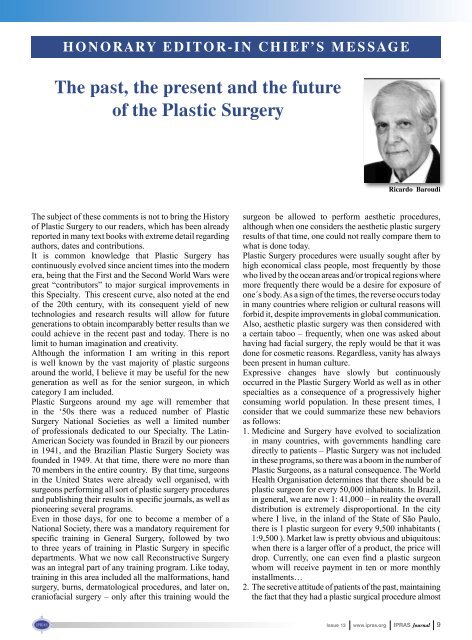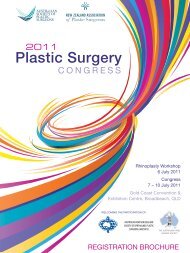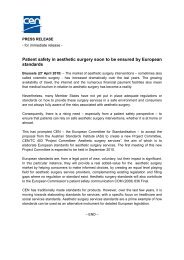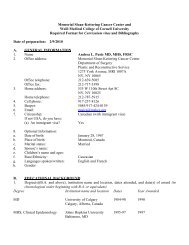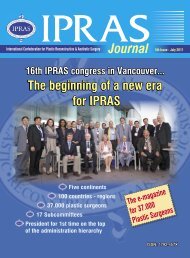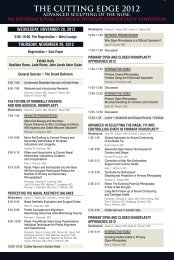Download pdf file - Ipras
Download pdf file - Ipras
Download pdf file - Ipras
You also want an ePaper? Increase the reach of your titles
YUMPU automatically turns print PDFs into web optimized ePapers that Google loves.
H O N O R A R Y E D I T O R - I N C H I E F ’ S M E S S A G E<br />
Ôhe past, the present and the future<br />
of the Plastic Surgery<br />
Ricardo Baroudi<br />
The subject of these comments is not to bring the History<br />
of Plastic Surgery to our readers, which has been already<br />
reported in many text books with extreme detail regarding<br />
authors, dates and contributions.<br />
It is common knowledge that Plastic Surgery has<br />
continuously evolved since ancient times into the modern<br />
era, being that the First and the Second World Wars were<br />
great “contributors” to major surgical improvements in<br />
this Specialty. This crescent curve, also noted at the end<br />
of the 20th century, with its consequent yield of new<br />
technologies and research results will allow for future<br />
generations to obtain incomparably better results than we<br />
could achieve in the recent past and today. There is no<br />
limit to human imagination and creativity.<br />
Although the information I am writing in this report<br />
is well known by the vast majority of plastic surgeons<br />
around the world, I believe it may be useful for the new<br />
generation as well as for the senior surgeon, in which<br />
category I am included.<br />
Plastic Surgeons around my age will remember that<br />
in the ‘50s there was a reduced number of Plastic<br />
Surgery National Societies as well a limited number<br />
of professionals dedicated to our Specialty. The Latin-<br />
American Society was founded in Brazil by our pioneers<br />
in 1941, and the Brazilian Plastic Surgery Society was<br />
founded in 1949. At that time, there were no more than<br />
70 members in the entire country. By that time, surgeons<br />
in the United States were already well organised, with<br />
surgeons performing all sort of plastic surgery procedures<br />
and publishing their results in specific journals, as well as<br />
pioneering several programs.<br />
Even in those days, for one to become a member of a<br />
National Society, there was a mandatory requirement for<br />
specific training in General Surgery, followed by two<br />
to three years of training in Plastic Surgery in specific<br />
departments. What we now call Reconstructive Surgery<br />
was an integral part of any training program. Like today,<br />
training in this area included all the malformations, hand<br />
surgery, burns, dermatological procedures, and later on,<br />
craniofacial surgery – only after this training would the<br />
surgeon be allowed to perform aesthetic procedures,<br />
although when one considers the aesthetic plastic surgery<br />
results of that time, one could not really compare them to<br />
what is done today.<br />
Plastic Surgery procedures were usually sought after by<br />
high economical class people, most frequently by those<br />
who lived by the ocean areas and/or tropical regions where<br />
more frequently there would be a desire for exposure of<br />
one´s body. As a sign of the times, the reverse occurs today<br />
in many countries where religion or cultural reasons will<br />
forbid it, despite improvements in global communication.<br />
Also, aesthetic plastic surgery was then considered with<br />
a certain taboo – frequently, when one was asked about<br />
having had facial surgery, the reply would be that it was<br />
done for cosmetic reasons. Regardless, vanity has always<br />
been present in human culture.<br />
Expressive changes have slowly but continuously<br />
occurred in the Plastic Surgery World as well as in other<br />
specialties as a consequence of a progressively higher<br />
consuming world population. In these present times, I<br />
consider that we could summarize these new behaviors<br />
as follows:<br />
1. Medicine and Surgery have evolved to socialization<br />
in many countries, with governments handling care<br />
directly to patients – Plastic Surgery was not included<br />
in these programs, so there was a boom in the number of<br />
Plastic Surgeons, as a natural consequence. The World<br />
Health Organisation determines that there should be a<br />
plastic surgeon for every 50,000 inhabitants. In Brazil,<br />
in general, we are now 1: 41,000 – in reality the overall<br />
distribution is extremely disproportional. In the city<br />
where I live, in the inland of the State of São Paulo,<br />
there is 1 plastic surgeon for every 9,500 inhabitants (<br />
1:9,500 ). Market law is pretty obvious and ubiquitous:<br />
when there is a larger offer of a product, the price will<br />
drop. Currently, one can even find a plastic surgeon<br />
whom will receive payment in ten or more monthly<br />
installments…<br />
2. The secretive attitude of patients of the past, maintaining<br />
the fact that they had a plastic surgical procedure almost<br />
Issue 13 www.ipras.org IPRAS Journal 9


